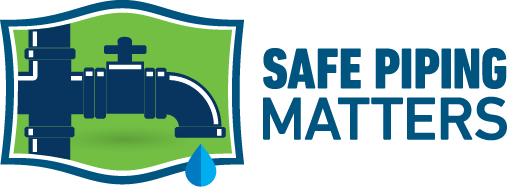How to Pick the Safest Pipes for your Building
Piping is a fundamental aspect of every building. It provides potable water, plumbing, heating, ventilation, air conditioning, and more. However, it can also present a number of safety hazards when inappropriate materials are used: exacerbating fire risks, leaching harmful chemicals into drinking water, allowing dangerous substances to penetrate and permeate into pipes, and posing a threat to the environment. It is essential that building owners and contractors are aware that not all piping materials are created equal. Below are five questions to ask yourself when selecting a piping material for your building.
Is copper- and iron-based piping safe in fires?
A huge concern in terms of safety is whether or not the pipes are a fire hazard. Firefighter and Plumber associations recently called for a ban on plastic piping in hotels, hospitals, nursing facilities, high-rise residential structures, and healthcare facilities. When burned, plastic emits dense smoke containing high amounts of toxins and carcinogens such as mercury and phthalates, as well as hydrochloric acid, which has extreme corrosive potential in the human lung. Additionally, plastics exhibit very high flame-spread characteristics of up to two feet per second. By contrast, copper and iron pipes do not pose a fire hazard and are a favored material for fire-protection system (i.e., sprinkler systems) because they do “not burn or support combustion.” Unlike plastic, copper has a ”high melting point, and is unlikely to melt” in the event of a fire. Moreover, safety data sheets assert that copper meets the criteria for safety relative to any physical, environmental, or health related hazard in fires.
Can substances permeate through the pipes?
Pipes that are permeable can allow contaminants, such as benzene, toluene, ethylbenzene, and xylene (BTEX), an established carcinogen, to enter the water supply from external sources. BTEX is regulated by the EPA due to its link to cancer and can penetrate water lines through volatilization, dissolution, sorption, and biodegradation. Piping systems made from metal are impervious to permeation while, plastic pipes such as Polyethylene (PEX), PP, and Polyvinyl chloride (PVC) are at risk and should not be installed in these conditions. Copper and iron, on the other hand, are impervious, lead-free, and antimicrobial, preventing outside chemicals from contaminating the water system. Copper and iron also can withstand conditions that cause plastic pipes to crack and allow contaminants to penetrate into the water supply – safely protecting the water from all external substances.
Does the material of the pipe leach contaminants into the water supply?
Studies show that the majority of substances that leach through common plastic pipes such as Polyethylene (PE), PEX, PVC, and others are carcinogenic, toxic, or unregulated. At least 23 substances that are known human toxins have been found to leach into potable water lines. Copper and iron pipes, as mentioned earlier, are impermeable and will not allow any contaminants to leach into the water supply. The Environmental Working Group states that copper piping as the safest form of piping in regards to leaching, and copper’s impenetrable nature has made it a favored replacement material for lead pipes across the country. Leaching can be detrimental to the purity and healthiness of drinking water, and it’s important to understand what types of pipes are susceptible to leaching. Seth Siegel, New York Times Bestselling author of “Troubled Water: What’s Wrong with What We Drink”, has been critical of the substances that plastic piping leaches into drinking water, particularly vinyl chloride, saying:
“When ingested, vinyl chloride [element of PVC piping] can affect the central nervous system with symptoms including dizziness, headache, fatigue, and even loss of consciousness. Vinyl chloride has been definitively linked to liver cancer, and, as mentioned earlier, is one of a limited number of chemicals that U.S. officials have concluded should be classified as a “known human carcinogen” (Siegel, Trouble Water, p.114)
For a list of the piping types that have been known to leach, click here.
Does the piping reduce the quality, add undesirable odors, or change the taste of your drinking water?
A scientific investigation into odd odors and tastes in drinking water found that test tap water came back smelling like “waxy plastic citrus,” “fruity plastic,” and “burning plastic” (among others) when sampled. These odors and tastes are telltale signs of contaminants leaching into the water supply, which can cause detrimental health effects. The study found that the odorous waters came exclusively from plastic piping. The presence of copper or iron in water (in low concentrations) is “not harmful,“ however it may add a slight distinct taste or smell. Metal corrosion is a contributor to water odor, taste, and/or quality, however copper is a non-corrosive metal.
Do the pipes pose a greater threat to the environment and public safety?
Last but not least, decision makers should consider sustainable and environment-friendly materials when choosing piping for your building. Plastic piping, such as PVC, has been known to present difficulties in the recycling process due to the presence of additives such as lead and cadmium. Plastic piping is considered as a contaminant in recycling streams, and it has been reported that PVC pipes present a direct environmental and human health threat throughout its lifecycle. Most plastic pipes (such as PVC) are not biodegradable or degradable, and will “retain their form for decades,” breaking down into microplastics and becoming a burden to the environment. By contrast, copper and iron metals are both durable and recyclable, creating a substantially lower impact on the environment than other piping materials.
When choosing a piping material for a construction or renovation projects, builders should assess available information on the safety hazards that each presents. Installing materials that leach chemicals into water, create fire hazards, and threaten the environment put building occupants in real danger of both short- and long-term health risks.
